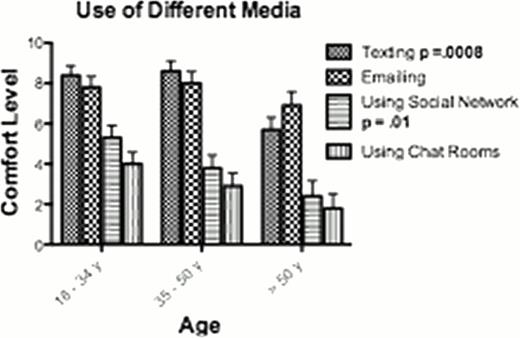Abstract
Abstract 4698
Information technology (IT) in general, and mobile technology in particular, is increasingly used in health care management. Mobile health tools have the potential to increase health care quality, reduce disease burden among individuals and health communities alike, as well as reduce healthcare disparities. Currently, there is a lack of data about ability and interest of patients with hemoglobinopathies, especially sickle cell disease (SCD) and thalassemia (Thal), to use IT interventions as part of their heath care management. This study was designed to ascertain the current use of IT, particularly mobile technology, in adult patients with hemoglobinopathies, as well as readiness to use mobile and other IT devices in the management of their disease. To do so, we sought to measure the ownership and use of IT devices (computers, mobile phones, and tablets) in a predominantly SCD population and the comfort level in using those devices to communicate socially and with health providers via text messages, emails, social media, or chat rooms. The study goal was to gather data pertinent to the potential use of mobile technology in clinical care, patient or provider education, and research interventions.
The study consisted of a questionnaire-based telephone survey gathering patients' demographics and current use of IT, particularly mobile technology. Patients were also asked to rate their comfort level with computers and smartphones (0: not comfortable to 10: extremely comfortable) and their level of interest in the use of mobile devices for health care management. Using an IRB approved protocol, patients were randomly selected from the list of all patients that received care at the center in the preceding two years.
One hundred adult patients with hemoglobinopathy and longitudinal follow-up at the outpatient clinic were enrolled. All patients approached agreed to participate. More than 95% of patients had SCD; the rest had thalassemia or other hemoglobin variants. Fifty-seven percent were female. Forty percent were 18–34 years old, 34% were 35–50 years old, and 25% were older than 50 years. Ten percent (10%) of patients reported not having a high school diploma (HS-dip), 36% had a HS-dip without further education, 48% were college graduates, or had attended some college, and 6% were attending graduate school, or had achieved an advance degree. These four groups were regrouped into two (HS-dip or less vs. attended or graduated from college) for analysis. Eighty-four percent (84%) reported owning a computer device, i.e. desktops, laptops, tablets, iPads. Ninety-two percent (92%) reported having a mobile phone.
Modes of communication were examined by age and education level. For all age and education groups, texting and emailing were preferred over social media, and particularly chat rooms (p<.0001), Figures A and C. The older age group reported lower comfort levels with texting (p=.0008) and using social network (p=.01) than did younger groups (18–34 and 35–49), Figure A. Similarly, The older age group reported lower comfort levels with using computers (p=.02) and smartphones (p=.003) to communicate with providers than did the younger groups, Figure B. There were no statistical differences in the comfort level for communication with provider by education groups, except for higher comfort level communicating by computer for those with higher education level (p=.01). Gender was not associated with differences in comfort level for any of the parameters studied.
This study suggests the feasibility of appropriate disease-specific health information technology (HIT) solutions for SCD clinical care, patient education, and patient-oriented research interventions
No relevant conflicts of interest to declare.
Author notes
Asterisk with author names denotes non-ASH members.




This feature is available to Subscribers Only
Sign In or Create an Account Close Modal